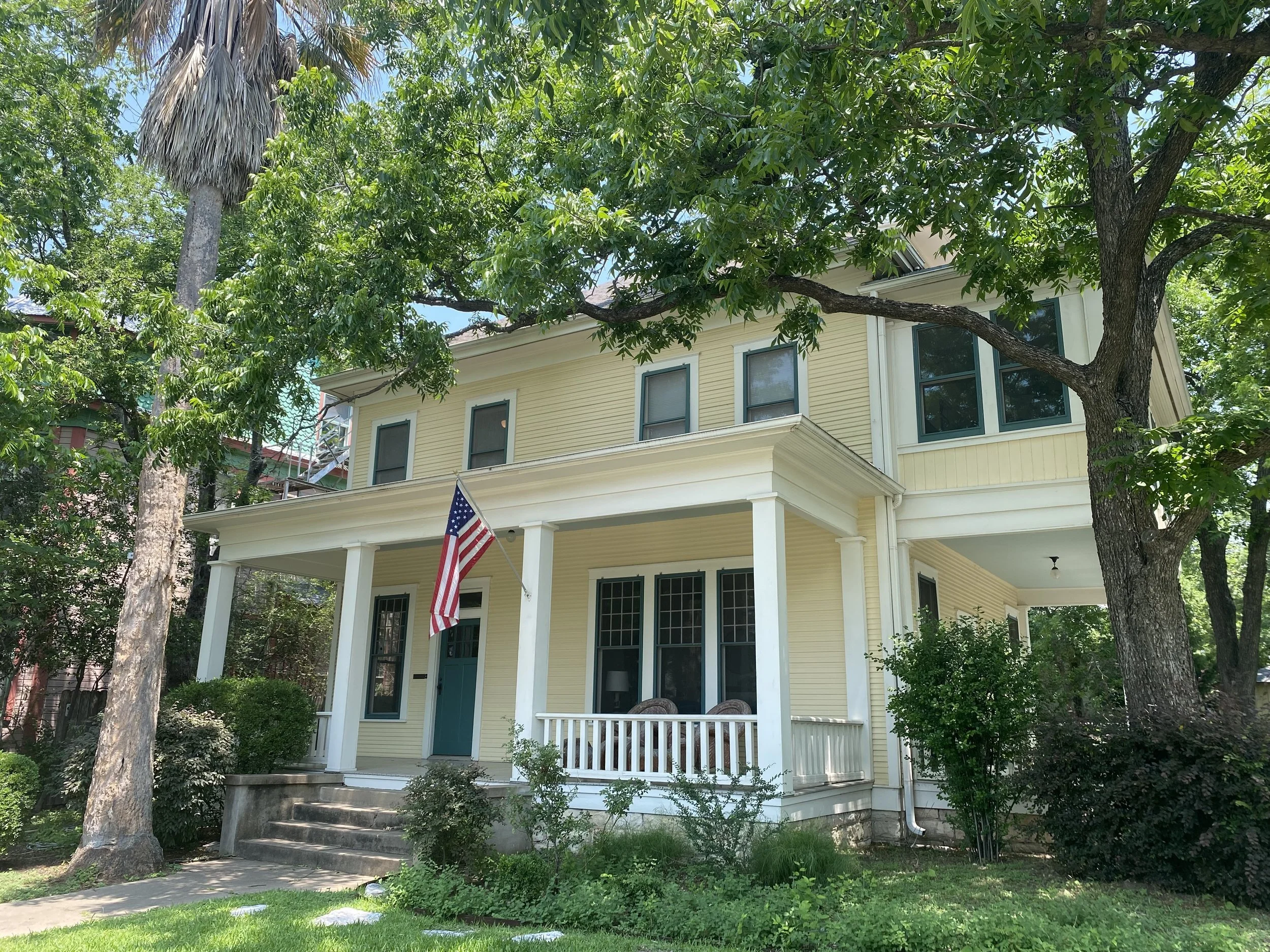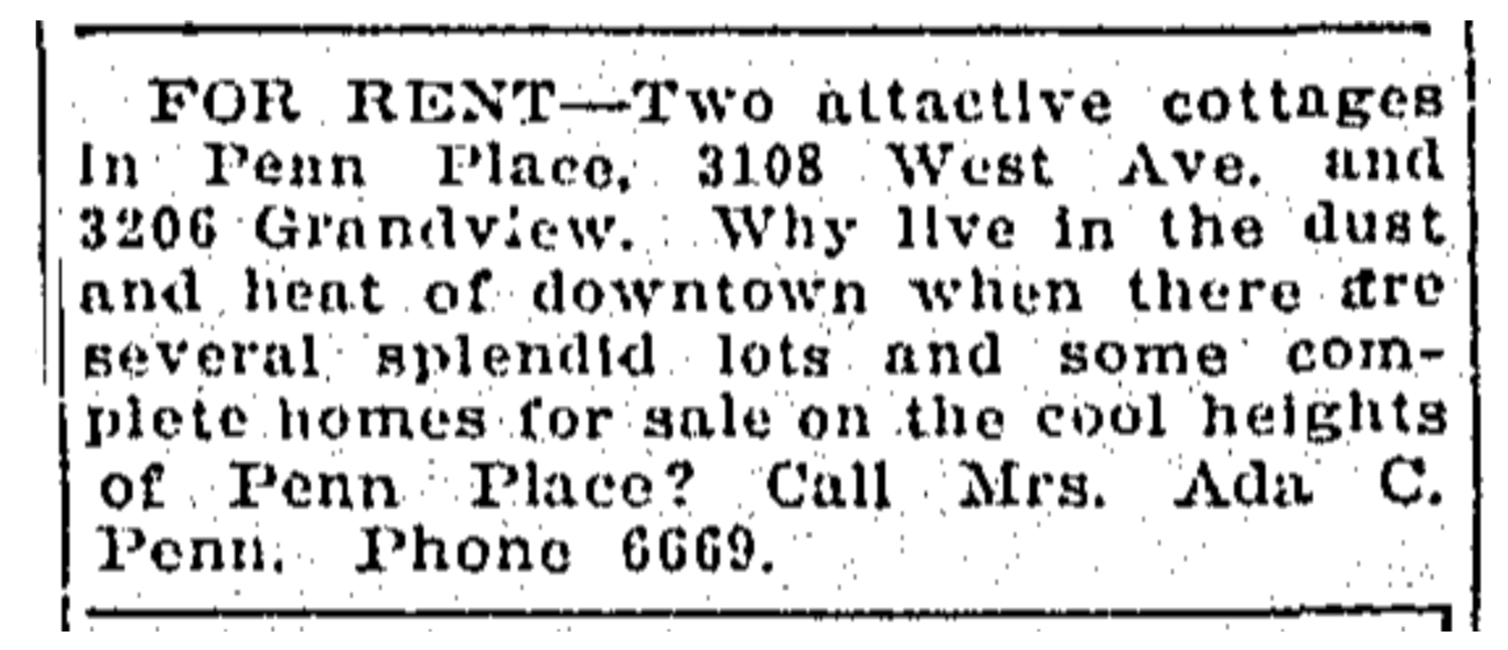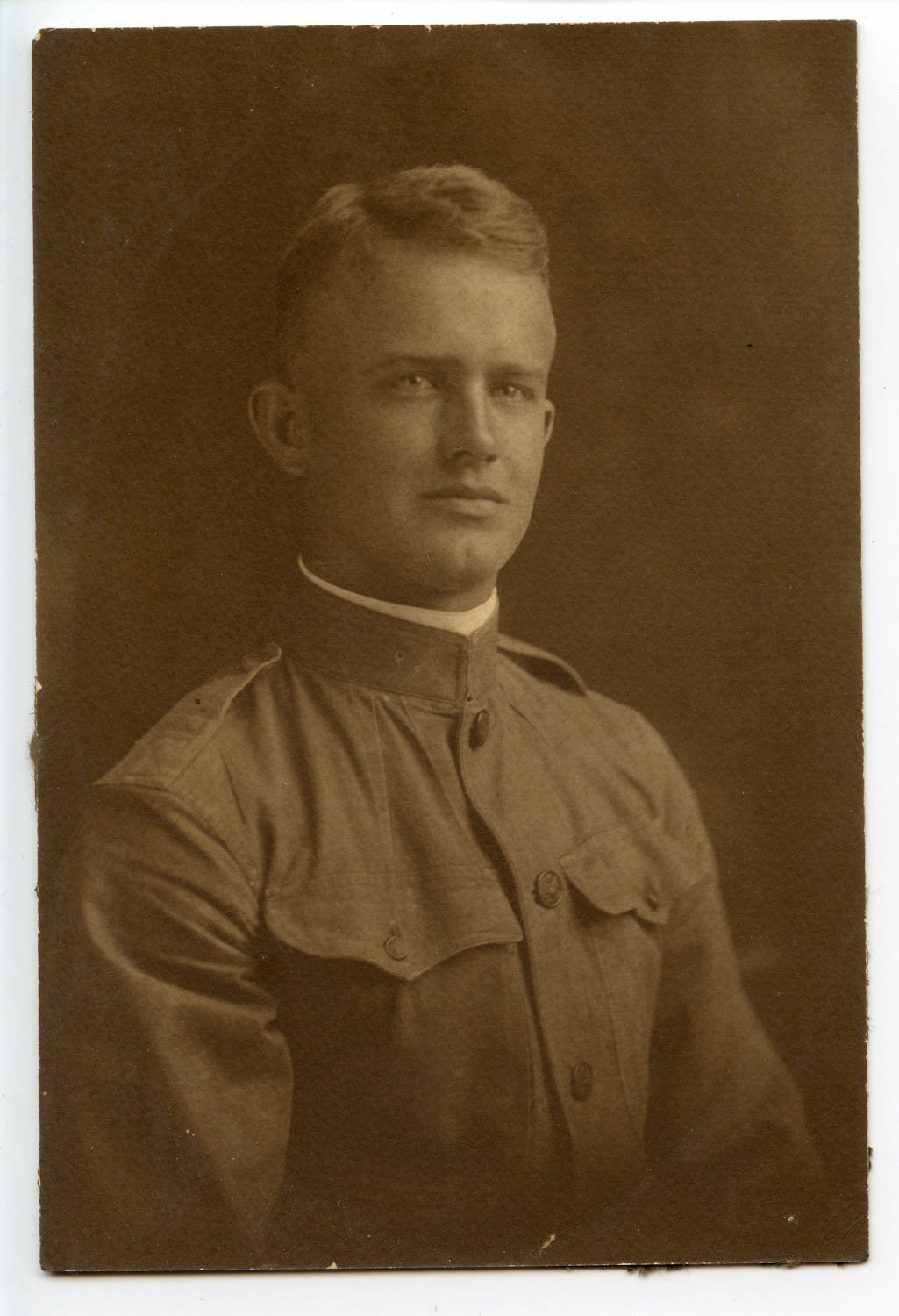The Life of Ada C. Penn: Designer, Buisinesswoman, Trailblazer
Portrait of Ada Penn, 1945 (Wolff, Gail. "Pioneer Spirit Still Alive in Texas." The Austin American (1914-1973), Mar 11, 1945)
Ada C. Read Penn, a resident of Austin in the early 20th century, is an important figure in the history of north central Austin. She was responsible for much of the development in what is known today as Austin’s Heritage Neighborhood, a rectangular area just south of the Austin State Hospital. It is bounded by Guadalupe Street, W 29th Street, Lamar Boulevard, and W 38th Street.
Ada Caroline Read was born to Dr. and Mrs. Rhosa Read in 1867 and raised in Texarkana. Once she was grown, Ada studied education at Huntsville State Teachers College and completed graduate work at Chicago University. She returned to Texarkana to serve as principal of their high school before moving to Taylor to become a teacher. It was here that she met her future husband, Robert Penn, who was then the city attorney in Taylor. The pair was married in 1889.
The Penn family moved to Austin in 1902 when Robert was appointed District Judge of the Williamson-Travis District. They purchased the 1839 stone home that would one day become known as the “Heritage House” for their growing family. The home had been built over sixty years before the Penn family's arrival in Austin for Captain Baker, a military man that served under Mirabeau B. Lamar. Although it is located on West Avenue today, at the time the Penn’s purchased the home the street was still called “Insane Asylum Avenue.” This was because of its proximity to the Austin State Hospital, which was constructed in 1861 as the “State Lunatic Asylum.”
Judge Penn died unexpectedly in 1909. His death left the 42 year old Ada alone and unsupported, along with their 9 children who were aged between 11 months and 18 years old at the time. Although Robert left everything he had to Ada, she knew that it wouldn’t be enough to continue supporting her and her children for long. She needed to figure out a way to provide for her children long term. Ada decided to leverage one of the few assets she had to provide for her children–land. Ada determined that she could subdivide her ten acre property and develop the land into homes to cater to the professors at the University of Texas. It was at this time that Ada reportedly enrolled in night classes to learn drafting so she could make her plan a reality. She subdivided her land into 40 lots and she called the development Penn Place. Ada would plan out a home, then hire a contractor to carry out the work. The following are a few examples of homes that Ada is said to have designed herself:
700 W. 32nd Street, built circa 1922
3108 West Avenue, built circa 1923
901 W 31st Street, built circa 1912
It is uncertain exactly how many homes Ada was responsible for creating over the years. By 1928, the Austin American reported that over the last fifteen years Ada was responsible for building “upward of 100 houses” in the Penn Place development. Although the validity of this claim seems somewhat dubious given the size of the development, the article noted that these were “good houses and good looking ones, filled with individualistic touches which [added] beauty and convenience.” It is interesting to note that Ada’s accomplishments are reported in an article discussing women’s hobbies in Austin. This demonstrates that Ada’s contributions, although recognized for their quality and style, were perhaps not viewed as seriously as that of a male builder. Another article published in 1945 claimed that she was involved in either the construction or renovation of approximately forty homes in the area, which seems more plausible. Family members of Ada have stated that she was responsible for designing at least 18 homes in the area. Regardless of exactly how many homes Ada was involved with, it is certain that she had a lasting impact on the urban fabric of the Heritage neighborhood.
Ada was an entrepreneurial woman with a strong business savvy. She knew that getting tenants to move to a home located on Insane Asylum Avenue might be a difficult task, so she successfully petitioned the City Council to change the name of the street so that it was an extension of West Avenue instead. She advertised the homes she built and renovated in both the Austin American and the Austin Statesman. Her advertisements often took on a convincing tone, asking the reader why they would want to live in the “dust of downtown” when they could live at one of her “splendid lots” instead.
A 1923 newspaper advertisement for homes in Penn Place ("Classified Ad 1 -- no Title." The Austin Statesman (1921-1973), May 13, 1923)
In addition to her successful business sense, Ada was devoted to her family throughout her life. She took pride in the fact that all of her children, including her daughters, went to college. Seven of them graduated from the University of Texas at Austin. Unfortunately, the death of her husband was not the only tragedy that Ada would have to endure in her lifetime. When World War I broke out, three of her sons, Rhesa, Albert, and Eugene went off to war. Tragically only two came back. Eugene perished in an airplane accident during training in Italy in 1918. Penn Field, a landing field that was established in South Austin shortly after his death, was named in Eugene’s honor. Her eldest son Robert would also tragically die in a car accident in 1931.
Portrait of Eugene Penn, circa 1918 (PICB-20896 Austin History Center)
Despite her personal tragedies, Ada was well known for the way she brought the community together. Throughout Ada’s life she often entertained at Penn House. Garden parties, political functions, community celebrations, and even flower shows all took place at the Penn House. As the Penn Place community was developed, Ada left room to include a tennis court for residents to use. The court was such a success that players even formed their own tennis club. As the years went by, many of Ada’s children stayed in Austin–some even lived in houses in Penn Place. By the time that Ada passed away in 1955, the Penn family had grown to over sixty members because Ada had so many grandchildren and great grandchildren. Ada lived to be nearly 90 years old and was buried next to her husband in Oakwood Cemetery in Austin.
A few years after Ada’s passing, the West Avenue home she had lived in for over 50 years was sold to the Heritage Society of Austin (which would become Preservation Austin in 2012). The home was in a state of disrepair when it was purchased by the nonprofit in 1958. The Heritage Society sought to restore the building and for it to serve as an example of preservation to the rest of the city. It was at this time that the West Avenue property became known as “Heritage House.” The beautiful home became one of the City of Austin’s first historic landmarks in 1975, and it functioned as the Heritage Society of Austin’s homebase until the organization sold it in 1979.
Unfortunately, the Heritage House was not a strong enough example of preservation to keep the Heritage neighborhood exactly as it was. Like the rest of Austin, the Heritage neighborhood has gone through many changes since the early 20th century. Unfortunately, some of the homes Ada designed have been lost over the years. For example, there is a parking lot on Grandview Street where two of Ada’s homes once stood. Although there aren’t protections in place now for the majority of homes in the Heritage area, there could be in the future. In fact, a 2021 historic resource survey of North Central Austin that HHM & Associates completed for the City of Austin noted that the Heritage Neighborhood is likely eligible as a district on the National Register of Historic Places and recommended the area as a City of Austin historic district.
Penn House, later known as Heritage House (Kennedy, Craig. [Heritage House, (East elevation)], photograph, April 4, 1974, Texas Historical Commission via The Portal to Texas History)
-
“Ada C. Penn in the U.S. Find a Grave Index, 1600s-Current..” HeritageQuest. https://www.ancestryheritagequest.com/discoveryui-content/view/75882356:60525?_phsrc=AST11&_phstart=successSource&gsfn=ada&gsln=penn&ml_rpos=1&queryId=61d3e392a8bf1ac7514a71be6f747895
“Ada Penn in the 1900 United States Federal Census.” HeritageQuest. https://www.ancestryheritagequest.com/discoveryui-content/view/44580641:7602?_phsrc=AST7&_phstart=successSource&gsfn=ada&gsln=penn&ml_rpos=3&queryId=d250560ed2083a0269a029efef3f43a8
“Ada Read in the 1880 United States Federal Census.” HeritageQuest. https://www.ancestryheritagequest.com/discoveryui-content/view/6569704:6742?_phsrc=AST9&_phstart=successSource&gsfn=ada&gsln=read&ml_rpos=1&queryId=7eeaf2a380df2eb846f931870bf7e9ce
Art Leatherwood, “Penn Field,” Handbook of Texas Online, accessed May 14, 2022, https://www.tshaonline.org/handbook/entries/penn-field. Published by the Texas State Historical Association
Brammer, Bill. "Little Lady Rules Over Big House Contentedly." The Austin Statesman (1921-1973), Jan 13, 1954, https://atxlibrary.idm.oclc.org/login?url=https://www.proquest.com/historical-newspapers/little-lady-rules-over-big-house-contentedly/docview/1559207143/se-2?accountid=7451.
"Bride-Elect Honored." The Austin American (1914-1973), Jun 05, 1927, https://atxlibrary.idm.oclc.org/login?url=https://www.proquest.com/historical-newspapers/bride-elect-honored/docview/1616952707/se-2?accountid=7451.
"Building Boom on in Austin: Passage of Bonds Gives Added Impetus." The Austin American (1914-1973), May 27, 1928, https://atxlibrary.idm.oclc.org/login?url=https://www.proquest.com/historical-newspapers/building-boom-on-austin/docview/1643641388/se-2?accountid=7451.
"Eugene Penn, Austin Boy, is Killed in Aero Accident in Italy." The Statesman (1916-1921), May 22, 1918, https://atxlibrary.idm.oclc.org/login?url=https://www.proquest.com/historical-newspapers/eugene-penn-austin-boy-is-killed-aero-accident/docview/1619609276/se-2?accountid=7451.
“Heritage Homes Tour.” Heritage Society of Austin, 2006.
"Heritage Group Sets Open House." The Austin Statesman (1921-1973), Dec 31, 1971, https://atxlibrary.idm.oclc.org/login?url=https://www.proquest.com/historical-newspapers/heritage-group-sets-open-house/docview/1514475831/se-2?accountid=7451.
HHM & Associates, Inc. “City of Austin: Historic Building Survey Report for North Central Austin. West Campus, North University, Heritage, Bryker Woods, and North Hyde Park.” 2021. 133-145. https://www.austintexas.gov/sites/default/files/files/Housing_%26_Planning/Historic%20Preservation/Historic%20Surveys/2021_NCA_WestCampus_NUni_Heritage_BrykerWoods_NHydePark/_Historic-Bldg-Survey_North-Central-Austin_FINAL_2021-01-08.pdf
"The Hobby Horse." The Austin American (1914-1973), Oct 07, 1928, https://atxlibrary.idm.oclc.org/login?url=https://www.proquest.com/historical-newspapers/hobby-horse/docview/1643656932/se-2?accountid=7451
Kendall, Elizabeth A. "Shrubs are Necessary for Blooms." The Austin American (1914-1973), Jul 30, 1933, https://atxlibrary.idm.oclc.org/login?url=https://www.proquest.com/historical-newspapers/shrubs-are-necessary-blooms/docview/1611380390/se-2?accountid=7451.
"Mother is Enthroned for Today." The Austin American (1914-1973), May 11, 1930, https://atxlibrary.idm.oclc.org/login?url=https://www.proquest.com/historical-newspapers/mother-is-enthroned-today/docview/1611535285/se-2?accountid=7451
"Mrs Ada Penn to Build $4,000 Residence." The Austin American (1914-1973), May 27, 1928,https://atxlibrary.idm.oclc.org/login?url=https://www.proquest.com/historical-newspapers/claud-traweek-awarded-contract-harrell-home/docview/1643641649/se-2?accountid=7451.
"Mrs. Penn Succumbs at Home." The Austin American (1914-1973), Jun 26, 1955, https://atxlibrary.idm.oclc.org/login?url=https://www.proquest.com/historical-newspapers/mrs-penn-succumbs-at-home/docview/1611052037/se-2?accountid=7451 .
“Past Beauties Restored.” The Austin Statesman (1921-1973), October 29, 1961.
"Penn Home Is Zinnia Show Setting." The Austin Statesman (1921-1973), Jun 28, 1933, https://atxlibrary.idm.oclc.org/login?url=https://www.proquest.com/historical-newspapers/penn-home-is-zinnia-show-setting/docview/1610381576/se-2?accountid=7451.
"Penn Family Upset Home may be Sold by Heritage Group." The Austin American Statesman (1973-1980), Aug 16, 1975, Evening ed., https://atxlibrary.idm.oclc.org/login?url=https://www.proquest.com/historical-newspapers/penn-family-upset-home-may-be-sold-heritage-group/docview/1500154539/se-2?accountid=7451.
“R L Penn in the Texas, U.S., Wills and Probate Records, 1833-1974.” HeritageQuest. https://www.ancestryheritagequest.com/discoveryui-content/view/1974310:2115?_phsrc=AST23&_phstart=successSource&gsfn=robert&gsln=penn&ml_rpos=1&queryId=7c3a87149bf2c7cd8211c5b5000151aa
Wolff, Gail. "Pioneer Spirit Still Alive in Texas." The Austin American (1914-1973), Mar 11, 1945, https://atxlibrary.idm.oclc.org/login?url=https://www.proquest.com/historical-newspapers/pioneer-spirit-still-alive-texas/docview/1611601359/se-2?accountid=7451
PRESERVATION AUSTIN IS INDEBTED TO THE FOWLER FAMILY FOUNDATION FOR MAKING THIS RESEARCH POSSIBLE.







